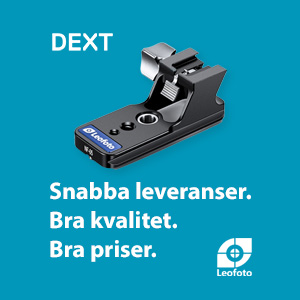KanonCanon
Aktiv medlem
Steves digicams hade visst gjort en liten miss och lagt ut en pressrelese för D60 som egentligen skulle komma imorgon! 
Canon Introduces the EOS D60: 6.3 Megapixel SLR
Camera With Interchangeable Lenses: Ideal For
Studio / Catalog Pros And Advanced Amateurs
High Resolution, Improved Autofocus with Illuminated Focusing Points, and
Simultaneous Recording of RAW / JPEG Files Make New D60 an Outstanding Value
LAKE SUCCESS, N.Y. - February 23, 2002 - Canon U.S.A., Inc., a subsidiary of Canon Inc. (NYSE: CAJ), continues to answer the needs of professional photographers and enthusiasts with the introduction of the EOS D60 digital SLR. Developed with the needs of studio and catalog photographers in mind, the new D60, with its 6.3 megapixel (effective) resolution, provides photographers with the high performance, advanced
features, and creative flexibility they expect from an EOS SLR camera.
The new EOS D60 replaces the extremely popular EOS D30 digital SLR model and
retains many of its advanced features, while adding new and improved features including a 3-point AF system with more responsive performance, especially in low-light conditions; 3 illuminated viewfinder focusing points; and the ability to capture images simultaneously in RAW and JPEG, a valuable feature for photographers who need to transmit images immediately but want to maintain a high-quality archive file for future use. In addition, improvements in the camera's signal processing system allow photographers to make exposures as long as 30 seconds without the assistance of a Noise Reduction feature.
"Studio photographers expressed the need for a digital camera that offers high resolution without sacrificing the functions and flexibility Canon's EOS System cameras provide," said Yukiaki Hashimoto, vice president and general manager, Photographic Products Group, Canon U.S.A. "The camera's 6.3 megapixel CMOS sensor, coupled with the ability to capture images in both RAW and JPEG formats, make the D60 the perfect tool for studio photographers and photo enthusiasts everywhere," added Mr.Hashimoto.
The EOS D60's high resolution and outstanding color reproduction is made possible by a newly developed and proprietary 6.52 megapixel (total)/6.3 megapixel (effective), single-plate CMOS sensor with 3072 x 2048 square pixels, 12-bit analog-to-digital conversion and an on-chip RGB primary color filter array. The sensor is the same size as the EOS D30's at 15.1 x 22.7mm, resulting in a focal length conversion factor of 1.6x compared to the 35mm format.
The EOS D60 can record images in any one of six (6) JPEG settings plus RAW, including 2048 x 1360 pixel and 1536 x 1024 pixel JPEG settings not found in the EOS D30. D60 RAW files contain an embedded 2048 x 1360 JPEG image that can be extracted with the supplied driver software, making them ideal for photographers who need to view or transmit images quickly but need to retain maximum image quality for future editing.
The D60's autofocusing system is three times more sensitive in low light than the EOS D30's (EV 0.5 vs. EV 2). At the same time, the built-in AF assist beam is more effective than it was before. These changes result in significantly improved performance. Additionally, in response to D30 user feedback, active focusing points are now illuminated in red directly on the focusing screen, making it easier to confirm focusing
point selection and AF completion.
Other feature improvements include an illuminated LCD data panel on top of the
camera, making it simpler to view and change camera settings in low light; a brighter
LCD monitor for easier viewing of menus and recorded images in bright light; new custom functions to tailor the camera's operation for individual preferences; and a new in-camera setting that allows photographers to store up to 3 sets of Shooting Parameters including contrast, saturation, sharpness and color tone.
Because it is based on the EOS D30, the EOS D60 inherits many of that camera's advanced features including a built-in E-TTL flash, 11 shooting modes, 3 AF modes, 3 metering patterns, and shutter speeds ranging from 1/4000 to 30 seconds plus Bulb.
The D60's burst mode can capture up to 8 consecutive images at 3 frames per second at all image quality settings including RAW mode. The D60 is equipped with USB 1.1 and NTSC/PAL video out ports as well as an N3-series remote control socket, a dedicated hot shoe for EX-series Speedlites and a PC terminal for external flash units.
Image data is stored on CompactFlash cards including CompactFlash Type I and II,
enabling users to take advantage of the IBM Microdrive and other high-capacity
storage media. The lithium-ion Battery Pack BP-511, which is included with the
camera, provides enough power to take approximately 490 images at normal
temperatures.
The EOS D60 is bundled with an upgraded software package featuring powerful
drivers based on those supplied with the professional EOS-1D camera, but newly
upgraded for compatibility with Windows XP. Canon is also cooperating with Apple Computer to ensure that the D60 will soon be supported by the Image Capture function of OS X. Additional Canon utilities such as ZoomBrowser EX, PhotoRecord, ImageBrowser, USB Mounter, RAW Image Converter, PhotoStitch and RemoteCapture
are also supplied, together with complimentary copies of Apple QuickTime 5.0 and
Adobe Photoshop 5.0 LE.
EOS D60 optional accessories include Battery Grip BG-ED3, Compact Power
Adapter CA-PS400, DC Coupler DR-400, Interface Cable IFC-200PCU, Video Cable
VC-100, and Neckstrap EW-100DB.
The EOS D60 measures 5.9 x 4.2 x 3.0-inches and weighs a mere 27.5 ounces (body only). It will be available at authorized retailers by the end of March with pricing to be announced.
Canon Introduces the EOS D60: 6.3 Megapixel SLR
Camera With Interchangeable Lenses: Ideal For
Studio / Catalog Pros And Advanced Amateurs
High Resolution, Improved Autofocus with Illuminated Focusing Points, and
Simultaneous Recording of RAW / JPEG Files Make New D60 an Outstanding Value
LAKE SUCCESS, N.Y. - February 23, 2002 - Canon U.S.A., Inc., a subsidiary of Canon Inc. (NYSE: CAJ), continues to answer the needs of professional photographers and enthusiasts with the introduction of the EOS D60 digital SLR. Developed with the needs of studio and catalog photographers in mind, the new D60, with its 6.3 megapixel (effective) resolution, provides photographers with the high performance, advanced
features, and creative flexibility they expect from an EOS SLR camera.
The new EOS D60 replaces the extremely popular EOS D30 digital SLR model and
retains many of its advanced features, while adding new and improved features including a 3-point AF system with more responsive performance, especially in low-light conditions; 3 illuminated viewfinder focusing points; and the ability to capture images simultaneously in RAW and JPEG, a valuable feature for photographers who need to transmit images immediately but want to maintain a high-quality archive file for future use. In addition, improvements in the camera's signal processing system allow photographers to make exposures as long as 30 seconds without the assistance of a Noise Reduction feature.
"Studio photographers expressed the need for a digital camera that offers high resolution without sacrificing the functions and flexibility Canon's EOS System cameras provide," said Yukiaki Hashimoto, vice president and general manager, Photographic Products Group, Canon U.S.A. "The camera's 6.3 megapixel CMOS sensor, coupled with the ability to capture images in both RAW and JPEG formats, make the D60 the perfect tool for studio photographers and photo enthusiasts everywhere," added Mr.Hashimoto.
The EOS D60's high resolution and outstanding color reproduction is made possible by a newly developed and proprietary 6.52 megapixel (total)/6.3 megapixel (effective), single-plate CMOS sensor with 3072 x 2048 square pixels, 12-bit analog-to-digital conversion and an on-chip RGB primary color filter array. The sensor is the same size as the EOS D30's at 15.1 x 22.7mm, resulting in a focal length conversion factor of 1.6x compared to the 35mm format.
The EOS D60 can record images in any one of six (6) JPEG settings plus RAW, including 2048 x 1360 pixel and 1536 x 1024 pixel JPEG settings not found in the EOS D30. D60 RAW files contain an embedded 2048 x 1360 JPEG image that can be extracted with the supplied driver software, making them ideal for photographers who need to view or transmit images quickly but need to retain maximum image quality for future editing.
The D60's autofocusing system is three times more sensitive in low light than the EOS D30's (EV 0.5 vs. EV 2). At the same time, the built-in AF assist beam is more effective than it was before. These changes result in significantly improved performance. Additionally, in response to D30 user feedback, active focusing points are now illuminated in red directly on the focusing screen, making it easier to confirm focusing
point selection and AF completion.
Other feature improvements include an illuminated LCD data panel on top of the
camera, making it simpler to view and change camera settings in low light; a brighter
LCD monitor for easier viewing of menus and recorded images in bright light; new custom functions to tailor the camera's operation for individual preferences; and a new in-camera setting that allows photographers to store up to 3 sets of Shooting Parameters including contrast, saturation, sharpness and color tone.
Because it is based on the EOS D30, the EOS D60 inherits many of that camera's advanced features including a built-in E-TTL flash, 11 shooting modes, 3 AF modes, 3 metering patterns, and shutter speeds ranging from 1/4000 to 30 seconds plus Bulb.
The D60's burst mode can capture up to 8 consecutive images at 3 frames per second at all image quality settings including RAW mode. The D60 is equipped with USB 1.1 and NTSC/PAL video out ports as well as an N3-series remote control socket, a dedicated hot shoe for EX-series Speedlites and a PC terminal for external flash units.
Image data is stored on CompactFlash cards including CompactFlash Type I and II,
enabling users to take advantage of the IBM Microdrive and other high-capacity
storage media. The lithium-ion Battery Pack BP-511, which is included with the
camera, provides enough power to take approximately 490 images at normal
temperatures.
The EOS D60 is bundled with an upgraded software package featuring powerful
drivers based on those supplied with the professional EOS-1D camera, but newly
upgraded for compatibility with Windows XP. Canon is also cooperating with Apple Computer to ensure that the D60 will soon be supported by the Image Capture function of OS X. Additional Canon utilities such as ZoomBrowser EX, PhotoRecord, ImageBrowser, USB Mounter, RAW Image Converter, PhotoStitch and RemoteCapture
are also supplied, together with complimentary copies of Apple QuickTime 5.0 and
Adobe Photoshop 5.0 LE.
EOS D60 optional accessories include Battery Grip BG-ED3, Compact Power
Adapter CA-PS400, DC Coupler DR-400, Interface Cable IFC-200PCU, Video Cable
VC-100, and Neckstrap EW-100DB.
The EOS D60 measures 5.9 x 4.2 x 3.0-inches and weighs a mere 27.5 ounces (body only). It will be available at authorized retailers by the end of March with pricing to be announced.








